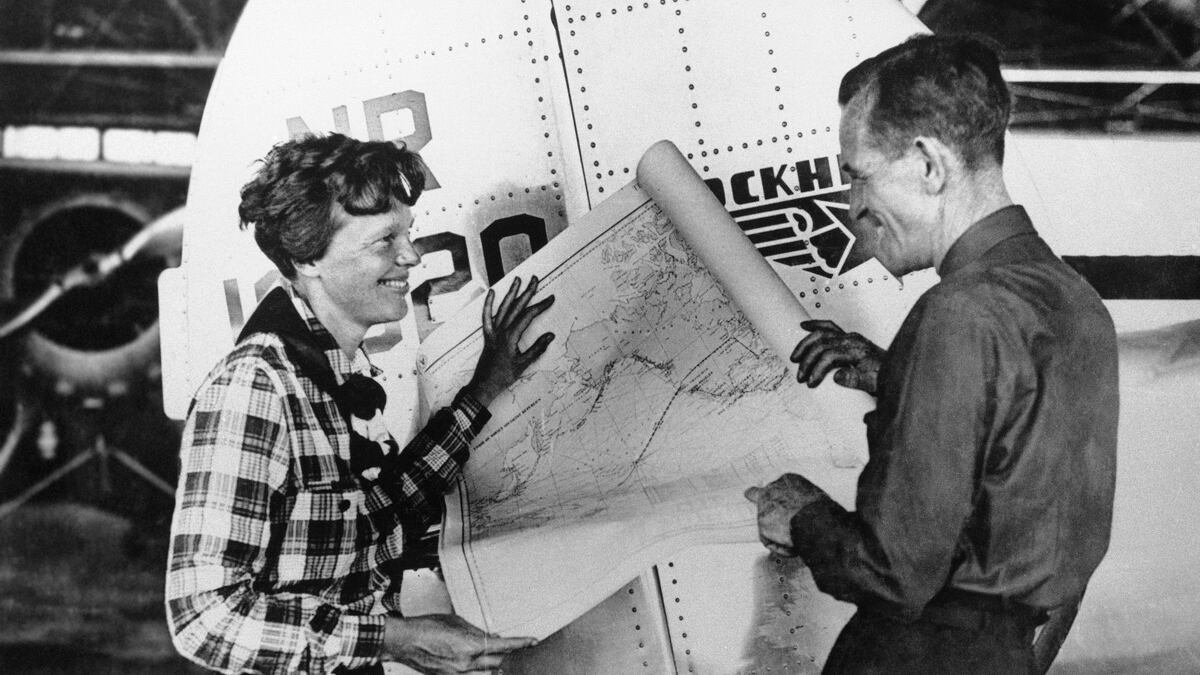The search for Amelia Earhart has been given new wings with Secretary of State Hillary Clinton’s announcement that new evidence may help to solve the mystery behind the famed American aviatrix’s disappearance.
An enhanced phototaken by a British soldier in October 1937 of a little-known Pacific island seems to show plane parts sticking out of the water just off the island’s shore.
“It shows an unexplained object protruding from the water on the fringing reef,” said Ric Gillespie, founder of the International Group for Historic Aircraft Recovery (TIGHAR), which will carry out the new expedition to search for Earhart this July.
In July 1937, the pioneering pilot and her navigator, Fred Noonan, disappeared over the Pacific as they tried to circumnavigate the globe. In an interview with Discovery News, Gillespie said he believes that Earhart and Noonan perished on the uninhabited Nikumaroro Island in the middle of the Pacific Ocean.
While most people believe that Earhart ran out of fuel and crashed into the Pacific, Gillespie said he’s confident he will be able to solve the mystery once and for all. Until then, however, theories will continue to abound about what happened to Amelia Earhart. The Daily Beast has rounded up the eight craziest.
1. Earhart was a spy.
The United States was at war in 1942, and Earhart’s flight brought her right over enemy territory. It only made sense, then, that the U.S. government should use her as a Trojan Horse to spy on the Japanese, conspiracy theorists say. They allege that Earhart was instructed to ditch her plane at the Marshall Islands, just off the Japanese coast, so that the Navy could come to her rescue, gain access to Japanese waters, and conduct reconnaissance. The U.S. eventually invaded and occupied the islands in 1944.

2. The Japanese shot down her plane and captured her. She ended up in prison on the island of Saipan where she either was executed or died of dysentery.
In this version of the conspirators’ spy thriller, Earhart’s plane was shot down. The Japanese knew that she was an American spy and treated her accordingly. There is no agreement on whether Earhart was beheaded at Garapan Prison or merely died there of dysentery, but either way, in this story, she perished in a Japanese jail.
3. She assumed a fake identity and lived until 1982 in New Jersey.
What do a retired Air Force colonel, a Catholic priest, and a Hollywood producer have to do with Amelia Earhart? They all believe she was secretly rescued from a Japanese prison, returned to the U.S., and assumed the identity of banker Irene Bolam until her death in 1982.
In 2003, Col. Rollin Reineck published Amelia Earhart Survived, an incendiary book that relied on former Seton Hall president and Catholic priest James F. Kelley’s claims that he had helped bring Earhart back to the U.S. after the Japanese surrendered in 1945. The book also included Hollywood producer Tod Swindell’s photo-overlays, which “proved” that Earhart and Bolam’s features were “congruent.”
The book built on an earlier work, Amelia Earhart Lives (1970), whose authors, Maj. Joe Gervais and Joe Klaas, were sued by Bolam for $1.5 million. They settled the case out of court.
4. She was stranded and died on Nikumaroro Island, and her remains were carried off by crabs.
“We know that in 1940, British Colonial Service officer Gerald Gallagher recovered a partial skeleton of a castaway on Nikumaroro,” TIGHAR founder Ric Gillespie told Discovery News in 2009. “The reason why they found a partial skeleton is that many of the bones had been carried off by giant coconut crabs.” Yes, this is the same Gillespie who will be leading the July expedition to Nikumaroro, and the same Gillespie whom Secretary Clinton says “carr[ies] our hopes.”
5. She was abducted by aliens.
On Aug. 28, 1995, another intrepid team of explorers voyaged into the unknown and did find Amelia Earhart. That day, USSVoyager Capt. Kathryn Janeway came across eight humans frozen in a death-like sleep and brushed the dust off one of the humans’ jackets. At that moment, she discovered that “A. Earhart” had been abducted by aliens. In other words, Star Trek: Voyager capitalized on a theory that Earhart had been abducted by aliens and created an episode—which first aired on Aug. 28, 1995—based on that premise.
6. Fred Noonan, her navigator, was too drunk to operate the equipment.
The first published reference to Noonan’s alleged alcoholism was in The Search for Amelia Earhart, a 1966 book by journalist Fred Goerner. The author points to an April 1937 car crash in which the police supposedly noted that the driver, Noonan, “had been drinking,” and suggests that Noonan’s drinking problem was to blame for Earhart’s disappearance. Many stories about Noonan’s drinking habits have since surfaced. The only problem? According to the book Amelia Earhart’s Shoes, nobody can find Goerner’s police report. And it’s quite a stretch to assert that, just because Noonan had been drinking in April, he was drunk on that fateful night in July.
7. Amelia Earhart was captured by the Japanese and forced to broadcast their propaganda during WWII as Tokyo Rose.
During WWII close to 12 English-speaking women broadcast Japanese propaganda over the radio to taunt, traumatize, and confuse American soldiers. The Americans called these women “Tokyo Rose.” After Earhart’s disappearance, rumors began to spread that she had been captured by the Japanese and was being forced to read their propaganda. Her husband, George Putnam, personally investigated the reports but could not recognize his wife’s voice among the many Tokyo Roses.
8. She eloped with her navigator, Fred Noonan, to escape her fame.
Earhart was known to not be a fan of her own celebrity. In 1943 a film called Flight for Freedom used that knowledge to suggest that Earhart was in love with her navigator, Fred Noonan, and that she had faked her death to elope with him. The film focused on a fictional protagonist whose story echoed Earhart’s but influenced dozens of real Earhart biographies. There is no solid evidence that Earhart was having an affair, and it was her husband who pressured her to take Noonan on the flight, but the romantic notion that Earhart faked her own death to follow her heart resonates to this day.






